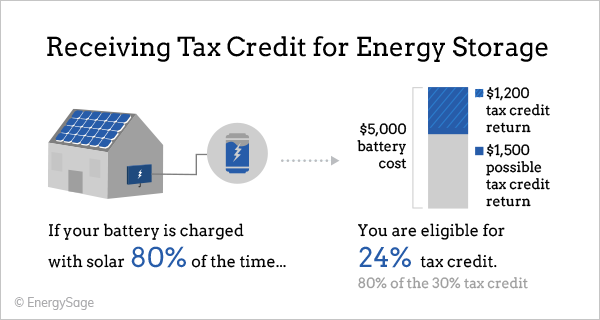
Why Energy Storage Should be Eligible for the ITC
Amy Hou | January 7, 2019 | Energy & Sustainability
Last November, the Solar Energy Industries Association (SEIA) and a coalition of clean energy advocacy groups sent a letter to Congressional leaders, urging them to make energy storage technology eligible for the investment tax credit (ITC). What would this mean for the industry, and why is it important? Let’s break it down.
The ITC as it stands today
The ITC, also known as the federal solar tax credit, is a 30 percent tax credit claimed against the tax liability of residential, commercial, and utility investors. Simply put, a homeowner, business, or utility can deduct 30 percent of the cost of a new solar system from their federal taxes with the ITC.
The ITC is one of the best incentives for solar in the United States. EnergySage shoppers, for instance, save an average of $9,000 with the ITC. But right now, it only applies to solar systems, and not solar batteries. That means that investments in energy storage technology don’t receive the same benefits.
Under some circumstances, energy storage technology can be eligible for the ITC. For homeowners, the battery must be charged by on-site solar panels, not from the grid. Similarly, businesses can receive the tax credit if they charge their batteries with renewable energy at least 75 percent of the time.
What energy storage eligibility would do
As we can see, the ITC’s benefits for energy storage are limited. That’s why the letter to Congress calls for energy storage technology to be explicitly included as an ITC-eligible resource. If Congress acts on it, residential and commercial solar customers could earn tax benefits without limitation.
Eligibility would ensure a level playing field for storage technology to compete against other energy resources, and support the growth of the solar economy as a whole. Energy storage supports more than 90,000 jobs in the U.S. today, and with ITC eligibility, would empower companies to obtain better financing, create more jobs, and become more globally competitive.
“Energy storage systems are critical to modernization of the electric grid.”
“Energy storage systems are critical to modernization of the electric grid,” wrote the authors of the letter. “The National Governors Association has underscored the multiple benefits of energy storage to save utilities, businesses, and households money while enhancing grid reliability and resilience.”
Solar + storage in 2019
Battery storage technology is crucial to not only encouraging solar adoption, but also modernizing the grid. By storing energy during off-peak periods and providing additional energy during on-peak periods, storage can take significant strain off the grid, driving stability and resilience.
The good news is: even without ITC eligibility, the adoption of storage isn’t set to slow down any time soon. “Solarize programs running during 2018 saw over 50 percent of participants purchasing battery storage with solar,” said Don Moreland, founder of Solar CrowdSource. “We expect to see this trend continue into 2019.”
Urjanet CEO Sanjoy Malik agrees: “The melding of PV and battery storage technology will be pivotal to the growth of solar in 2019. As storage advances and states like California mandate time-of-use (TOU) rates, we also expect to see a growing need for granular monitoring of on-peak, off-peak, and demand usage.”
Learn how granular utility data can help drive efficiency and accelerate solar sales.
You might also be interested in:
- 10 Experts Weigh in on the Future of Solar
- US Energy: Strategies for Weathering the New Tariffs
- Shedding Light on Solar: How Utility Data Drives Revenue Growth
If you like what you’re reading, why not subscribe?
About Amy Hou
Amy Hou is a Marketing Manager at Urjanet, overseeing content and communications. She enjoys writing about the latest industry updates in sustainability, energy efficiency, and data innovation.
You May Also Like
Support Business Continuity by Embracing ESG
Honor Donnie | March 18, 2022 | Energy & Sustainability

